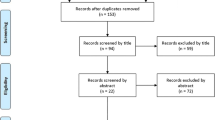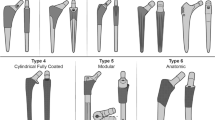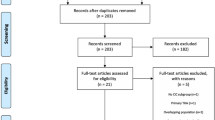Abstract
Background
Cemented femoral total hip arthroplasty may be one of the most successful surgical interventions of all time. However, although results are very encouraging over the early to mid-term followup, relatively few studies have analyzed the durability of these implants beyond 20 years followup. To evaluate the performance of contemporary implants, it is important to understand how previous implants perform at 20 or more years of followup; one way to do this is to aggregate the available data in the form of a systematic review.
Questions/purposes
(1) How durable is cemented femoral fixation in the long term (minimum 20-year followup) with respect to aseptic loosening? (2) Is the durability of cemented femoral fixation dependent on age of the patient? (3) Are the long-term results of the cemented femoral fixation dependent on any identifiable characteristics of the prosthesis such as surface finish?
Methods
A systematic review was performed to identify long-term studies of cemented femoral components. After application of inclusion and exclusion criteria to 1228 articles found with a search in PubMed and EMBASE, 17 studies with a minimum of 20-year followup on cemented femoral components were thoroughly analyzed in an attempt to answer the questions of this review. The quality of the studies reviewed was assessed with the Methodological Index for Nonrandomized Studies (MINORS) instrument. All studies were case series and cohort sizes ranged from 110 to 2000 hips for patients older than 50 years of age and 41 to 93 hips for patients younger than 50 years at the time of surgery.
Results
Among the six case series performed in patients older than 50 years of age, survivorship for aseptic loosening of the femoral component ranged from 86% to 98% at 20 years followup. There were no obvious differences for younger patients when analyzing the five studies in patients younger than age 50 years in which survivorship free from aseptic loosening for these studies ranged from 77% at 20 years in one study and 68% to 94% at 25 years in the other studies. Although data pooling could not be performed because of heterogeneity of the studies included here, it appeared that stems with a rougher surface finish did not perform as well as polished stems; survivorship of stems with rougher surface finishes varied between 86% and 87%, whereas those with smoother finishes ranged between 93.5% and 98% at 20 years.
Conclusions
Excellent long-term fixation in both older and younger patients can be obtained with cemented, polished femoral stems. These results provide material for comparison with procedures performed with newer cementing techniques and newer designs, both cemented and cementless, at this extended duration of followup.


Similar content being viewed by others
References
Berry DJ, Harmsen WS, Cabanela ME, Morrey BF. Twenty-five-year survivorship of two thousand consecutive primary Charnley total hip replacements: factors affective survivorship of acetabular and femoral components. J Bone Joint Surg Am. 2002;84:171–177.
Buckwalter AE, Callaghan JJ, Liu SS, Pedersen DR, Goetz DD, Sullivan PM, Leinen JA, Johnston RC. Results of Charnley total hip arthroplasty with use of improved femoral cementing techniques: a concise follow-up, at a minimum of twenty-five years, of a previous report. J Bone Joint Surg Am. 2006;88:1481–1485.
Callaghan JJ, Albright JC, Goetz DD, Olejniczak JP, Johnston RC. Charnley total hip arthroplasty with cement. J Bone Joint Surg Am. 2000;82:487–497.
Callaghan JJ, Bracha P, Liu SS, Piyaworakhun S, Goetz DD, Johnston RC. Survivorship of a Charnley total hip arthroplasty: a concise follow-up, at a minimum of thirty-five years, of previous reports. J Bone Joint Surg Am. 2009;91:2617–2621.
Callaghan JJ, Forest EE, Olejniczak JP, Goetz DD, Johnston RC. Charnley total hip arthroplasty in patients less than fifty years old: a twenty to twenty-five-year follow-up note. J Bone Joint Surg Am. 1998;80:704–714.
Callaghan JJ, Templeton JE, Liu SS, Pedersen DR, Goetz DD, Sullivan PM, Johnson RC. Results of Charnley total hip arthroplasty at a minimum of thirty years: a concise follow-up of a previous report. J Bone Joint Surg Am. 2004;86:690–695.
Clauss M, Gersbach S, Butscher A, Ilchmann T. Risk factors for aseptic loosening of Muller-type straight stems: a registry-based analysis of 828 consecutive cases with a minimum follow-up of 16 years. Acta Orthop. 2013;84:353–359.
Clauss M, Leum M, Ochsner PE, Ilchmann T. Fixation and loosening of the cemented Muller straight stem: a long-term clinical and radiologic review. J Bone Joint Surg Br. 2009;91:1158–1163.
Espehaug B, Furnes O, Engesaeter LB, Havelin LI. 18 years of results with cemented primary hip prostheses in the Norwegian Arthroplasty Register: concerns about some newer implants. Acta Orthop. 2009;80:402–412.
Halley DK, Glassman AH. Twenty- to twenty-six-year radiographic review in patients 50 years of age of younger with cemented Charnley low-friction arthroplasty. J Arthroplasty. 2003;18:79–85.
Howell JR, Blunt LA, Doyle C, Hooper RM, Lee AJC, Ling RSM. In vivo surface wear mechanism of femoral components of cemented total hip arthroplasties: the influence of wear mechanism on clinical outcome. J Arthroplasty. 2004;19:88–101.
Kavanagh BF, Wallrichs S, Dewitz M, Berry D, Currier B, Ilstrup D, Coventry MB. Charnley low-friction arthroplasty of the hip: twenty-year results with cement. J Arthroplasty. 1994:9:229–234.
Keener JD, Callaghan JJ, Goetz DD, Pederson DR, Sullivan P, Johnston RC. Twenty-five-year results after Charnley total hip arthroplasty in patients less than fifty years old: a concise follow-up of a previous report. J Bone Joint Surg Am. 2003;85:1066–1072.
Klapach AS, Callaghan JJ, Goetz DD, Olejniczak JP, Johnston RC. Charnley total hip arthroplasty with use of improved cementing techniques: a minimum twenty-year follow-up study. J Bone Joint Surg Am. 2001;83:1840–1848.
Lampropoulou-Adamidou K, Georgiades G, Vlamis J, Hartofilakidis G. Charnley low-friction arthroplasty in patients 35 years of age or younger: results at minimum of 23 years. J Bone Joint Surg Br. 2013;95:1052–1056.
Ling RSM, Charity J, Clive Lee AJ, Whitehouse SL, Timperley AJ, Gie GA. The long-term results of the original Exeter polished cemented femoral component. J Arthroplasty. 2009;24:511–517.
Makela KT, Esklinen A, Pulkkinen P, Paavolainen P, Remes V. Total hip arthroplasty for primary osteoarthritis in patients fifty-five years of age or older: an analysis of the Finnish Arthroplasty Registry. J Bone Joint Surg Am. 2008;90:2160–2160.
Makela KT, Esklinen A, Pulkkinen P, Paavolainen P, Remes V. Results of 3,668 primary total hip replacements for primary osteoarthritis inpatients under the age of 55 years: a follow-up of a previous report from the Finnish Arthroplasty Register. Acta Orthop. 2011;82:521–529.
Mohler CG, Callaghan JJ, Collis DK, Johnston RC. Early loosening of the femoral component at the cement-prosthesis interface after total hip replacement. J Bone Joint Surg Am. 1995;77:1315–1322.
Mullins MM, Norbury W, Dowell JK, Heywood-Waddington M. Thirty-year results of a prospective study of Charnley total hip arthroplasty by the posterior approach. J Arthroplasty. 2007;22:833–839.
Pedersen AB, Mehnert F, Havelin LI, Furnes O, Herberts P, Karrholm J, Garellick G, Makela K, Eskelinen A, Overgaard S. Association between fixation technique and revision risk in total hip arthroplasty patients younger than 55 years of age. Results from the Nordic Arthroplasty Register Association. Osteoarthritis Cartilage. 2014;22:659–667.
Schulte KR, Callaghan JJ, Johnston RC. The outcome of Charnley total hip arthroplasty with cement after a minimum twenty-year follow-up. J Bone Joint Surg Am. 1993;75:961–975.
Skutek M, Bourne RB, Rorabeck CH, Burns A, Kearns S, Krishna G. The twenty to twenty-five-year outcomes of the Harris Design-2 matte-finished cemented total hip replacement: a concise follow-up of a previous report. J Bone Joint Surg Am. 2007;89:814–818.
Slim K, Nini E, Forestier D, Kwiatkowski F, Panis Y, Chipponi J. Methodological index for non-randomized studies (MINORS): development and validation of a new instrument. ANZ J Surg. 2003;73:712–716.
Wroblewski BM, Siney PD, Feming PA. Charnley low-friction torque arthroplasty: follow-up for 30 to 40 years. J Bone Joint Surg Br. 2009;91:447–450.
Author information
Authors and Affiliations
Corresponding author
Additional information
One of the authors (JJC) receives royalties for intellectual property transfer from DePuy (Warsaw, IN, USA) and royalties for books edited from Lippincott Williams & Wilkins (Baltimore, MD, USA).
All ICMJE Conflict of Interest Forms for authors and Clinical Orthopaedics and Related Research ® editors and board members are on file with the publication and can be viewed on request.
Clinical Orthopaedics and Related Research ® neither advocates nor endorses the use of any treatment, drug, or device. Readers are encouraged to always seek additional information, including FDA-approval status, of any drug or device prior to clinical use.
About this article
Cite this article
Bedard, N.A., Callaghan, J.J., Stefl, M.D. et al. Systematic Review of Literature of Cemented Femoral Components: What Is the Durability at Minimum 20 Years Followup?. Clin Orthop Relat Res 473, 563–571 (2015). https://doi.org/10.1007/s11999-014-3876-3
Published:
Issue Date:
DOI: https://doi.org/10.1007/s11999-014-3876-3




